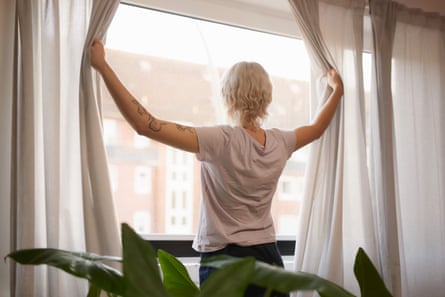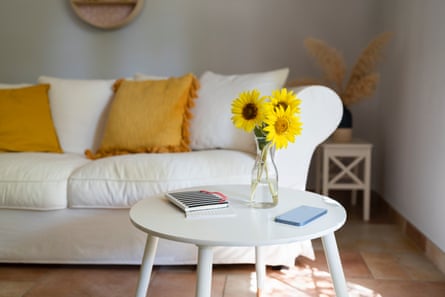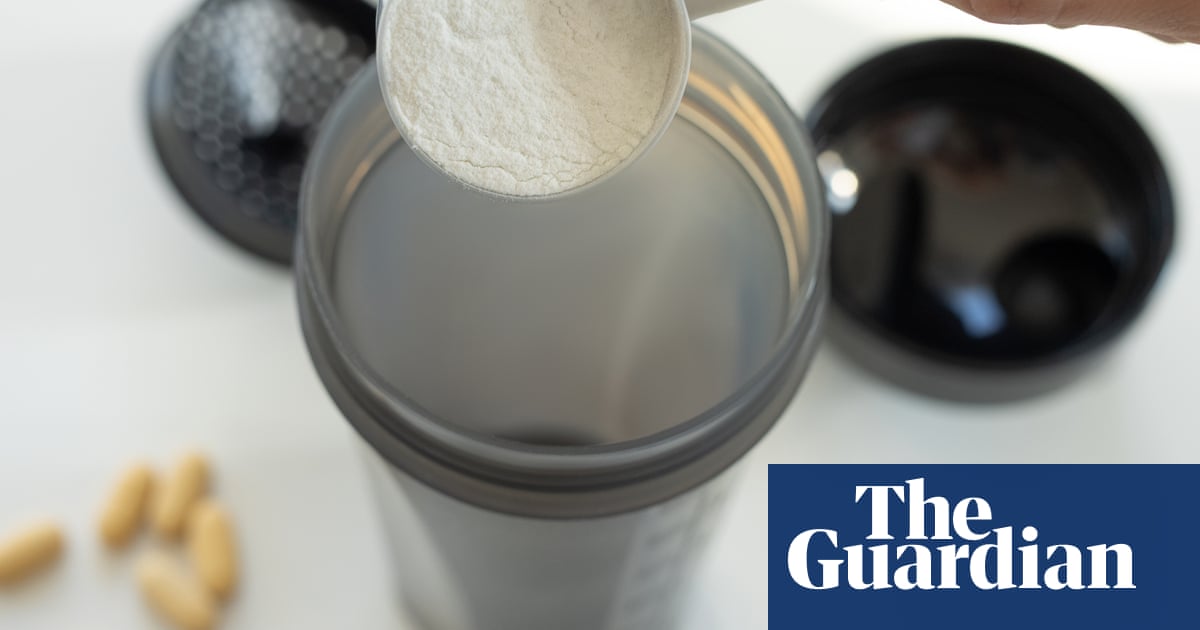Whatever the weather, June marks the start of what we consider summer in the northern hemisphere, and many of us are seized with a frenetic desire to make the most of it. We want our homes to be light, airy and inviting and our outside spaces full of colour and scent – but if you’re anything like me, that stuff doesn’t necessarily come naturally. Instead, I’m chasing bluebottles, sweating into my sofa and staring enviously over the neighbours’ wall at their impeccable garden. But in summertime the living really can be easy: I asked home and garden experts for their favourite simple ways to welcome the season.
Stimulate your senses
Sensory tweaks that instantly conjure summer are “so fricking cool”, says colour psychologist Tash Bradley, design director of Lick. A gentle hum of jazz in the background, a summery candle burning (basil or tomato leaf scents are instantly evocative), or, best of all, real greenery. You don’t need a garden to raid: “When you’re next on a walk, pick foliage or bring branches in – the trees are so luscious – and put them in vases around the house,” Bradley says. (Garden designer Sean Pritchard’s book Outside In is full of ravishing inspiration for this.)
Get ready to be spontaneous

“Embrace the spirit of a never-ending holiday by prepping your space for spontaneous gatherings,” says Rebecca Lowrey Boyd, design writer and author of the Wee Birdy newsletter. “Keep a ready-to-go drinks tray or a basket of picnic essentials on standby, so you’re always five minutes from hosting a garden soiree, or at least pretending you are. If you’re feeling fancy, throw in a sprig of mint and a set of cocktail napkins.” (Lowrey Boyd likes a “natty embroidered” Anthropologie set; I’ve found good ones on eBay.)
Sow selectively
“With a few honourable exceptions, once May is out of the way it begins to get a bit late for planting, and certainly for sowing things that will bulk up and present an impressively romantic spectacle for the summer months,” says Andrew Timothy O’Brien, garden writer and host of the Gardens, Weeds & Words podcast. “That said, some seeds sown in early June will get going remarkably quickly. On the veg front there’s French and runner beans, courgettes and pumpkins, lettuce, pak choi, sweetcorn and carrots. Ornamentals that you sow now will extend the season by flowering in later summer and into autumn: try nasturtiums, sunflowers or night-scented stocks. To avoid disappointment, make sure you’re using freshly bought seed, not something from a packet you’ve had sitting in the shed since lockdown.”

Let the mismatched garden magic happen
“I like things that maybe don’t quite go together,” says Allan Jenkins, former Observer gardening columnist and author of Plot 29. “Happy accidents are more interesting than regimented rows.” This time of year in the garden – or, in Jenkins’s case, on the allotment – is for spontaneity and serendipity. “From May onwards I will have beans, maybe peas. Sunflower seeds might find a home.”
Bring your holiday home
In her new book, Dopamine Decor, interior stylist and colour evangelist Kate Morgan recommends taking inspiration from holidays: the places you enjoy spending time in – cafes and bars, hotels, tavernas – and the treats you eat. Morgan is a big fan of fruit motifs. “When I think of a good holiday, I think of warm places, blue skies and lovely bowls of pineapples, coconuts, mangoes, watermelons, lemons and limes – and a fruity cocktail or two! Delicious zingy flavours and bright colours.” Her home is full of fruity touches, from a blueberry milk jug to a cherry toilet brush.
Get a summer scent
“A summer simmer pot is simple, quick and cost-effective,” says Lesley Bramwell, sustainable fragrance entrepreneur and author of Fragrance Your Home. “Add sprigs of summer plants – mint or eucalyptus – a handful of fresh rose petals or lavender buds and a few slices of lemon or orange to a large pan. Cover with water, filling the pot to around two-thirds full. Bring to the boil and then gently simmer. Add a few spices to bring warmth, like fresh ginger or cloves. As the pot simmers away, the steam will gently release summery aromas.”

Lighten up
Change your fabrics for lighter, breezier versions. “As a nation we are not particularly good at seasonal changes but, done well, they can feel like a full redecoration,” says design writer Kate Watson-Smyth, author of multiple books and award-winning interiors blog Mad about the House, and co-host of the The Great Indoors podcast. “I once met a Danish fashion designer who was baffled by our reluctance to swap things in and out during the year: ‘You change your clothes with the seasons, why not your cushions?’”
No need to stop at cushions: Morgan recommends swapping “duvet covers, tablecloths, shower curtains, blankets, rugs and towels” for lighter, brighter summery patterns. “Make like the Danes and change heavy thermal curtains for linen panels,” suggests Watson-Smyth. Lowrey Boyd agrees: “Your home will feel airier, brighter and, dare I say, almost continental. Less Victorian parlour, more Mediterranean hideaway.” She has her eye on Ikea’s crushed linen curtains for an affordable switch-up.
Give your coffee table a makeover
Watson-Smyth gives her coffee table a seasonal facelift. In winter it holds large coffee-table books, dark candles with heavier scents and decorative boxes of matches. “In summer the books return to the shelves, to be replaced with magazines, bud vases and perhaps a reed diffuser in a pretty glass bottle. Anything that refreshes the room will lift the mood.”
Draw the eye outside
“At this time of year,” says Bradley, “the best room in the house is the garden.” To connect indoors and out, she suggests repainting a door leading to outside space, or a window overlooking it, in a nature-inspired green or blue. “It’s a really quick win to zhoosh up a room, make it a focal point and draw the eye out into the garden.”

Help out your houseplants
Your plants are probably happier in summer, but they still need TLC. “As the light, temperature and length of the days increase, keeping up with watering is vital so our houseplants don’t wilt,” says Sarah Gerrard-Jones, author of The Plant Rescuer: The Book Your Houseplants Want You to Read. “Plants that may have only needed water every few weeks during winter might now need to be watered more frequently. The easiest way to know is to check the soil for moisture by sticking your finger deep into the pot, or weighing it in your hands. A pot that feels light indicates it’s time to water.”
Feed plants once a month through the summer growing season. It’s also a good time, Gerrard-Jones says, to check which need repotting. “A clear sign that a bigger pot is needed is roots growing out of the holes in the bottom, or the soil drying out quickly, which suggests there is little potting compost left.” Check for pests, too: “It’s far easier to get rid of one or two before it becomes a full-blown infestation.”
Get herbaceous
“Fill planters near the back door or window boxes with fresh mint, parsley, chives and rosemary plants,” says O’Brien. “That way they’ll always be on hand to snip for the kitchen, or to wrench off a sprig and stick it straight into a cocktail.” You don’t need to make a special garden centre trip – supermarket pots will do. I follow botanist James Wong’s advice to keep my supermarket basil alive: split up and thin out the dense tangle of seedlings, keep a few clumps of healthier ones and pot them up in good-quality compost.

Don’t worry about weeds – enjoy them
Tackling garden weeds can feel like a losing battle at this time of year, so how about not bothering? Gardener and landscape designer Jack Wallington specialises in working with, rather than against nature. His newsletter Wild Way is full of prompts and tips to reframe how we think about garden “pests” and “weeds”. “Wildflowers – plants like cow parsley, teasel, tufted vetch, yarrow, Welsh poppy, dandelions, hedge woundwort, ox eye daisies and lawn daisies – often flower longer and are more resilient to extremes in weather than many ornamental plants,” he says. “If you allow them, these wild plants multiply prolifically and then manage themselves, reducing maintenance; no need to grow from seed or water these sustainable plants.”
They also encourage and support other wildlife: “Many insects evolved to rely on them, and without that rich biodiversity many gardens feel lifeless to me,” Wallington says. Plus, they look great. “Wildflowers we’re told to rip out actually create the most contemporary and chic style. Best yet, of course, they’re free.”
… or actually encourage them
“It might sound bonkers,” says O’Brien, “but consider creating a weedy planter.” Weeds flourish when everything else is struggling. “These plants are what our soil wants to grow, and sometimes it can make sense to listen to what the garden is trying to tell us. Many weeds are attractive or sculptural. Think of the charming, daisy-like white and pink Mexican fleabane (erigeron karvinskianus); or Lady’s mantle (alchemilla mollis) with its chartreuse flowers and pale green leaves, which show off raindrops to such wonderful effect. Elevate your weeds by collecting a selection and sticking them in a pot or a trough, and placing it somewhere where you can regularly take a good long look at them.”
Discourage insects rather than destroying them
There’s nothing summer chic about the big fat flies thumping into my windows while a billion tiny ones host some kind of rave on my bananas. “We don’t want to be destroying insects; they’re essential for pollination,” says Bake Off legend and eco pioneer Nancy Birtwhistle, author of Clean and Green and the cookbook Nancy’s Green and Easy Kitchen. Instead, “it’s about repelling them”. Her strategy: halve a lemon and stud each half with cloves (or juice the lemon and fill the hulls with cloves) then place it in your kitchen or fruit bowl or by your houseplants. “Insects hate the smell of cloves. If they get a whiff, they’re off.” If you’re facing invasion from an ant army, Birtwhistle recommends squirting her homemade cleaning spray (160ml water, 60ml vinegar and 40ml surgical spirit) along their pathways.

And protect your woollies
“Now summer’s here, you may not be thinking about your woollen jumpers, but clothes moths very much are,” says Birtwhistle. “Protect your jumpers by putting them in sealed bags or boxes and by using a natural deterrent. Lavender is a great moth repellent and it’s in season now, so collect a few sprigs.”
Transform your tabletop
“Give your dining table (or the rickety one in the garden) a summer makeover with a bold, stripy tablecloth or some clashing printed napkins,” says Lowrey Boyd. No need for a splurge – grab a length of cheerful fabric or even a retro-inspired tea towel.” Add vibrant napkins (Lowrey Boyd fancies some “jolly ricrac numbers from RE”) and mismatched coloured candles. “Suddenly, every meal feels like a sun-drenched picnic, even if it’s beans on toast.”
As it heats up, chill out
“Just as summer really starts to get going and the weather is good for relaxing and entertaining in the garden, growth rates slow down and everything begins to look a little thirsty,” says O’Brien. “The temptation is to dash out and buy things to make the garden look good: replace the patio set, buy a shiny new barbecue and pick up some plants. The problem is, this kind of panic buying rarely hits the spot, and anything you plant now is going to need endless watering and attention to prevent it from looking knackered and carking it within a week of bringing it home.”
The secret to happy summer gardening, he says, is doing less (it’s the guiding philosophy of O’Brien’s book, To Stand and Stare: How to Garden While Doing Next to Nothing). “Learn to love what you’ve already got. Lawn looking a bit parched? Let it grow rangy and a bit straggly. Get to know the wildflowers that you’d otherwise spend precious hours decapitating, while bees and butterflies make the most of the nectar resource. You can restore order in autumn; summer is mainly for dossing about.” Amen to that.

 3 months ago
50
3 months ago
50

















































